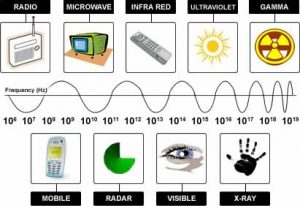Radiation Hazards
Mobile phones use ‘radio waves’ to transmit signals. Radio waves are just part of the ‘electromagnetic spectrum’, a map of all the energy waves that exist. The spectrum includes many familiar names, such as microwaves, infra-red and x-rays.

The spectrum is divided into different groups according to the frequency of these energy waves. This is measured in Hz, and represents how many waves arrive in a second. The higher the frequency, the more waves per second and the greater the possible danger to health.
Mobile phone frequencies are actually right on the border between radio waves and microwaves, so their emissions are sometimes referred to as microwaves.
Different types of radiation:
All parts of the electromagnetic spectrum are described as ‘radiation’, but not all radiation is the same.
At the top of the scale, ionizing radiation (as in radioactive decay or X-rays) has the ability to alter matter, including human cells and animal cells. It has very high energy which can change a molecule’s structure. This can have serious consequences – ionizing radiation can cause changes in the structure of DNA, leading to mutations and possible cases of cancer.
By contrast radio waves, such as in mobile/cellular phones, are at the other end of the spectrum. They have very low energy output, and do not have the ability to alter matter, so they are classed as non-ionizing radiation.
Leave a Reply